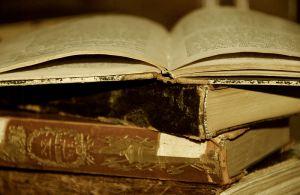Yesterday, 5 March, was World Book Day, and I missed it! But this morning I happened on this, which appeared on the wonderful site Interesting Literature, and loved it so much I had to share it with you. They're all great, but I think we will all appreciate learning the Japanese word 'tsundoku'.
 Interesting Facts about Books
Interesting Facts about Books
30 fun facts about books, in honor of World Book Day 2015
SF writer Isaac Asimov (1920-1992) is the only author to have published a book in all ten Dewey library categories.
When asked what book he’d like to have with him on a desert island, G. K. Chesterton replied, ‘Thomas’s Guide to Practical Shipbuilding.’
Hugh Lofting, author of Dr Doolittle, thought books should have a ‘senile’ category to complement the ‘juvenile’ section.
Dickens’s house had a secret door in the form of a fake bookcase. The fake books included titles such as ‘The Life of a Cat’ in 9 volumes.
Playwright Joe Orton went to prison in 1962 for defacing library books. One of the cartoons he drew shows an elderly tattooed man in trunks.
The first book bought on Amazon was called Fluid Concepts and Creative Analogies: Computer Models of the Fundamental Mechanisms of Thought.
Author James Frazer had to move out of his room at Great Court, London because the floor was threatening to give way under the weight of his books.
As well as being a real species of scorpion, a ‘book scorpion’ is someone who is hostile to books or learning; the phrase is first recorded in 1649 in a work by poet Andrew Marvell.
In order to feel close to it, Joan Didion often sleeps in the same room as the book she is working on.
The smallest book in the Welsh National Library is Old King Cole. It measures 1mm x 1mm and the pages can only be turned with a needle.
The first person Ray Bradbury asked out was a bookstore clerk; they married in 1947 and were together until her death in 2003.
The Japanese word ‘tsundoku’ means ‘buying a load of books and then not getting round to reading them’.
The most expensive book in the world costs (in theory) 153 million Euros and is only 13 pages long.
The word ‘shrine’ comes from the Latin scrinium meaning ‘chest for books’.
The word ‘boghandler’ is the Danish word for ‘bookseller’.
The Norwegian translation of the Mr Men book Mr Bump is called Herr Dumpidump.
Only 2% of the 1.2 million different books sold in the US in 2004 sold more than 5,000 copies.
In the sixteenth century, primers or learning books for children were known as ‘hornbooks’.
At high school, J. D. Salinger was so fond of acting that he signed the yearbook with the names of the roles he’d performed.
Geoffrey Chaucer’s ‘Treatise on the Astrolabe’ is possibly the first children’s science book written in English – he wrote it for his son.
The earliest known written instance of the word ‘book’ is in a book by Alfred the Great.
‘Bibliosmia’ is the enjoyment of the smell of old books.
Another word for a plagiarist is a ‘brain-sucker’; the word’s first recorded appearance in print (in 1781) was in reference to booksellers.
‘Incunabula’ means something in its early stages, especially any book printed before 1500; it comes from the Latin for ‘swaddling-clothes’.
Ford Madox Ford recommended that readers judge a new book, not by its first page, but by its 99th, the better to gauge the book’s quality.
In 2007, Stephen King was mistaken for a vandal when he started signing books during an unannounced visit to a bookshop in Australia.
Around £2.2 billion is spent on books in the UK each year. A fifth of this is spent on children’s books.
The most expensive printed book in the world is the 1640 Bay Psalm book from America. It sold in November 2013 for $14.2 million.
A ‘bouquinist’ is a dealer in ‘second-hand books of little value’.
The first book printed in Oxford was a study of the Apostles’ Creed. Its first page carried a misprint: it was dated 1468 rather than 1478.

